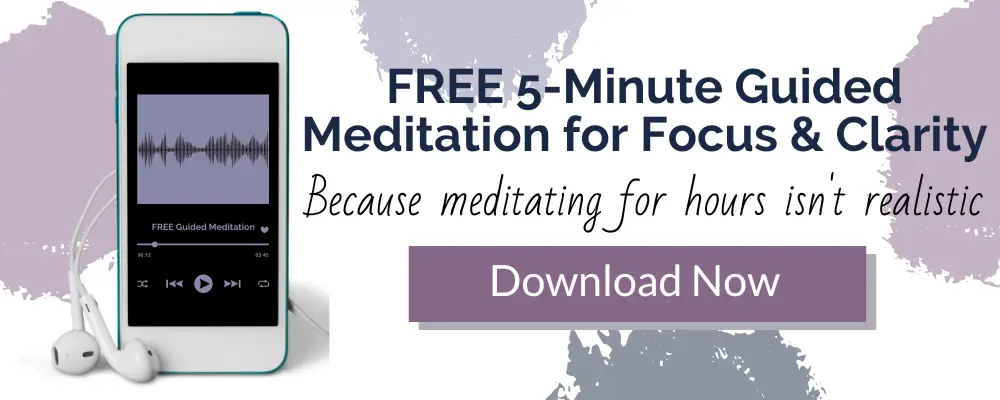Step by Step: How To Do Mantra Meditation for Beginners

Table of Contents
Meditation can be intimidating, especially if you’re just starting out. You’re sitting there, trying to clear your mind, but your thoughts are racing a million miles a minute. But fear not, my friend! I’ve got your back.
Today, we’re going to talk about how to do mantra meditation for beginners. This is a meditation technique where you repeat a word, phrase, or affirmation, to help you focus and calm your mind. It’s been around for thousands of years and is a popular tradition in many cultures. It’s also an excellent way to calm your mind even if you’re a total newbie.
I’ll walk you through the benefits, how to choose one, and even give you a step-by-step beginner’s guide on how to get started with your first session.
It’s really simple. You can start with just a few minutes a day and work your way up to longer sessions as you become more comfortable. So, grab a cushion, find a quiet spot, and give this method a try. Your mind (and body) will thank you!
Mantra Meditation Benefits
Before we get into the nitty-gritty of how to do this meditation, let’s first discuss why it’s worth your time.
Here we’ll cover the perks, and trust me, there are quite a few. From improving your psychological focus to activating your body’s relaxation response, there are plenty of reasons why this is a great addition to your routine.
So, let’s dive into the benefits to see why this method might be a game-changer for you.
Increased Focus & Concentration
Studies show this type of meditation can help you increase your focus and concentration. When your brain repeats a certain phrase or word during meditation, it can help cut through the clutter and noise of daily life, providing a mental anchor. It’s like giving your brain something to hang onto, allowing it to rest, refocus, and recharge.
Activates the Parasympathetic Nervous System
Meditation Mantras are the perfect mind-taming tool! The process of repeating phrases helps stimulate your parasympathetic nervous system (PNS), the part of your nervous system responsible for rest and digestion. Your PNS is the opposite of your sympathetic nervous system, which manages your “fight or flight” responses.
It can help switch you over to “rest and digest” mode, allowing you to chill out, digest your food better, sleep deeper, and enjoy life more. Basically, it resets or flips a switch in your mind that allows you to get into a state of Zen-like relaxation.
Physical & Mental Health Benefits
It’s not just a mind workout but an exercise that improves your overall wellness. It packs a real punch when it comes to physical and phycological advantages, too. Plus science backs it up!
Studies show that there are many benefits from helping to lower your blood pressure to boosting your mood, there are so many ways that meditation techniques can help you feel better, inside, and out.
So, let’s check out the dividends and how a little bit of time can go a long way for your well-being.
-
- Reduced Stress: Regular use can lower cortisol levels, the body’s primary stress hormone, leading to a more relaxed state of mind.
- Improved Concentration: Its repetitive nature can help improve focus and concentration, turning your mind into a laser-beam of mindfulness.
- Enhanced Emotional Well-being: The exercise can help in reducing anxiety and depression symptoms, promoting overall emotional wellness.
- Lowered Blood Pressure: The relaxation response is triggered and may help in reducing blood pressure, which is good news for your heart.
- Boosted Immunity: By reducing stress and promoting relaxation, you can enhance your body’s immune response.
- Better Sleep: The calming effect can help improve your sleep patterns, fighting off insomnia and promoting restful nights.
- Enhanced Self-Awareness: Regular meditation can foster a greater understanding of oneself, helping to cultivate a positive self-image and self-esteem.
- Pain Management: Studies have shown that self-examination can be a helpful tool in managing chronic pain.
- Improved Digestion: The relaxation response can enhance digestion, as stress and tension often disrupt gastrointestinal function.
- Increased Resilience: Adding it to your routine can help you better deal with stressful situations, enhancing your resilience and coping skills.
Choosing A Mantra
Choosing a chant is like choosing a favorite ice cream flavor. Sure, everyone has their favorites, but ultimately, the best choice is whatever makes you feel good and brings you joy.
Some people prefer classic Sanskrit phrases, the ancient spiritual language of the yogis, while others find peace in Zen, transcendental meditation, or even simple words or phrases in their own language.
If you need help finding something that works for you I have a list of simple easy to remember single-word affirmations in my article: 35 Inspiring One Word Mantras for Meditation: Find Your Calm.
Just remember, it should truly be yours. It should suit your needs and nourish your soul. Don’t worry about whether it’s fancy enough or if it fits in with what some influencers are doing. If repeating “I am peace” or “chocolate chip cookie dough” calms your mind, then, by all means, use it!
Step-by-Step Guide How to Do Mantra Meditation For Beginners
Once you’ve made your choice, it’s time to sit down and get meditating. The beauty is its simplicity. You don’t need a fancy yoga mat or transcendental soundtracks. You just need your lovely self and a spot of silence. Here’s how to do it:
Step 1: Find a Quiet Place
This doesn’t mean you have to book a flight to a remote Tibetan monastery (unless you want to, in which case, can I come?). A quiet space could be your bedroom, your garden, a park, or even your bathroom.
Pick any place that allows you to escape from distractions for a little while. It doesn’t have to be fancy, you just need to feel safe and secure.
Step 2: Get Comfortable
Finding a comfortable position can make or break your focus. It’s like finding the sweet spot on your pillow. If you find a comfortable position it will feel like you can stay there forever, but if you aren’t comfortable, you won’t be able to focus on your meditation practice no matter how hard you try.
Some prefer the classic lotus position, but feel free to experiment. Just make sure you’re comfortable and your back is straight.
Step 3: Set an Intention
Setting an intention is all about setting your goal for the journey. What do you want to get out of if? It’s the reason why you’re doing what you’re doing.
Your intention can be as simple as finding inner peace, having clarity, or reconnecting with yourself. Setting your intention ahead of time will also help you to have a clear point of focus throughout your session.
Step 4: Select a Mantra
Remember this can be anything from a word like “peace” or “love” to a phrase like “I am enough” or “all is well”. The key is to choose something that resonates with you and helps you feel calm and centered.
This will be your subconscious anchor. Just like how an anchor keeps a ship from drifting away into the ocean, an anchor keeps your mind from drifting away into a sea of distractions.
Step 5: Begin Your Meditation
Now that you’ve made your choice and are comfortable, it’s time to close your eyes and start repeating it silently. Let it resonate within you like the gentle rhythm of a soothing lullaby, calming your mind and heart.
If you’re feeling especially distracted, you can repeat your chosen phrase out loud. Try to focus all your attention on its sound and vibration.
Don’t worry if your mind starts to wander, gently bring your attention back to your affirmation.
Step 6: Take Your Time
You can start with just a few minutes a day and work your way up to longer sessions as you become more comfortable.
Remember to take this at your own pace. There’s no need to feel like you need to jump into an hour long session right away. Start with a few minutes and work your way up from there as you feel up to it.
Step 6: End Your Meditation
When you’re finished don’t just jump up and rush back into the world. Take a moment to sit quietly, absorbing the peace and tranquility you’ve cultivated.
Slowly allow yourself to become aware of the room around you again. Start to become aware of sounds, smells, and feelings around you. When you’re ready slowly blink your eyes open.
It’s like slowly waking up from a restful nap; you don’t want to jolt awake and lose all that relaxed goodness.
Additional Tips for Mantra Meditation
Now that you’ve got the basics down. Now, let’s go a step further with some additional tips that can enhance your meditation experience. This section is filled with useful advice to help you delve deeper into your quest for calm.
From using a mala to stay focused, to adding visualization techniques into your routine, these tips are meant to support and enrich and level up your meditation game.
Use a Mala
If you’re the kind of person who loses track of time easily, using a mala – a string of 108 beads – can be helpful. As you recite your affirmation, move from bead to bead.
Once you’ve completed the circle, you know you’ve meditated for a substantial amount of time. You can use this to time your session without having to use an alarm or timer.
Malas are also helpful for combating distractions. The act of moving from one bead to another gives you a tactile anchor to focus on.
Incorporate Visualization
Imagine your mind as a movie theater and your thoughts are the films being played. Visualization is the act of choosing what movie to play. It can be an excellent way to make your meditation more engaging.
Visualize your chosen sound, the energy it creates, or even the impact of meditation on your body and mind.
Try Walking Meditation
If you’re still struggling with a wandering mind, try repeating your chosen word or affirmation during a walking meditation. Many people find that walking meditation is even more effective than a seated meditation practice for quieting the mind and reducing stress.
I have a full article on the benefits, how to prepare, how to get started with walking meditation: Walk Your Way to Mindfulness: The Art of Walking Meditation.
Listen to Mantra Music
If you’re finding it challenging to keep your mind focused during your practice, try music or guided meditation might be the answer. This genre has rhythmic tunes, often with soothing harmonies, designed specifically to complement concentration.
This music can be a perfect tool for a couple of reasons. First, it helps to create a calming atmosphere that makes it easier for you to slip into a meditative state.
Secondly, it adds rhythm to your concentration. By timing your repetition with the beats of the music, it gives you a consistent pace, reducing the chances of your mind wandering off. Plus, if you’re using a language you’re not familiar with, like Sanskrit, meditation music can help with pronunciation and rhythm.
Frequently Asked Questions (FAQs)
This is the part where we address the most common questions that often swirl around.
How do I find my own mantra?
Finding your perfect word or phrase is like finding your favorite book – it’s deeply personal and might take some time. Experiment with different words or phrases until you find one that resonates with you.
What is an example of a mantra for meditation?
There are countless examples! Classic Sanskrit phrases for meditation include “Om Shanti Shanti Shanti” (Peace Peace Peace), “So Hum” (I am That), or even simple English ones like “I am at peace” or “Love and Light,”
“Om mani padme hum” is a traditional six-syllable Sanskrit phrase which was believed to help you achieve all your wishes for happiness in this life and all future lives.
Another example would be the five-syllable Hindu chant “Om Namah Shivaya” which is credited for infusing positive effects into your everyday life.
How long do mantras take to work?
The rewards come gradually with consistent ritual. Start with just 5-10 minutes per session and you should start noticing changes in a few weeks.
How many minutes should I chant a mantra?
Start with as little as 5 minutes a day, gradually increasing it to 15-20 minutes. Just like working out, you wouldn’t start with lifting the heaviest weights to begin with.
Try It For Yourself
Life’s too short to live in constant stress. So why not try this mantra practice for yourself? From stimulating your parasympathetic nervous system to improving your focus and concentration, there are so many benefits.
Give it a shot! It is an amazingly simple but powerful method. Remember, you’re a majestic ocean of calmness; all you need to do is realize it. Start today and let your journey to tranquility begin!














